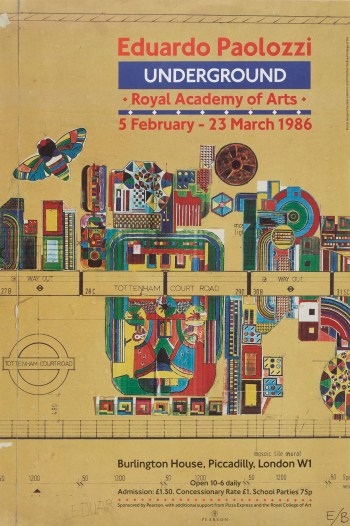Sir Eduardo Paolozzi RA (1924 - 2005)
RA Collection: People and Organisations
Pop Art pioneer Eduardo Paolozzi was a sculptor and printmaker whose large-scale public commissions transformed spaces including the British Library courtyard and the London Underground.
Born in Edinburgh to Italian parents, Paolozzi grew up reading American magazines and pasting pictures he liked into a scrapbook; a habit that would eventually inform some his most iconic works. In 1940, when Italy entered World War II in support of Germany, the teenage Paolozzi was interned as an enemy alien. His father and grandfather were put on a ship to Canada and drowned when it was targeted by a German U-boat.
After being released from internment, Paolozzi was conscripted and served a year in the army before faking madness to secure a discharge. He studied art in Edinburgh and London before moving to Paris in 1947, where he met Georges Braque, Constantin Brancusi and Alberto Giacometti. The same year he produced the collage I Was A Rich Man’s Plaything, retrospectively deemed one of the first examples of Pop Art.
Paolozzi didn’t display the work until 1952, when he presented it with over 40 other collages at the inaugural meeting of what became known as the Independent Group. Founded by Paolozzi and artists including photographer Nigel Henderson and sculptor Richard Hamilton, the Group championed the use of found objects and popular culture in art. In 1956 they staged This is Tomorrow, a groundbreaking exhibition at the Whitechapel Gallery in which they transformed the space into a series of immersive installations.
Paolozzi worked prolifically throughout the 1960s, holding several teaching positions, experimenting with sculpture and continuing to develop his screenprinting. One of his most notable works from this time is As Is When, a series of prints inspired by the philosopher Ludwig Wittgenstein. He was appointed a CBE in 1968 and elected a Royal Academician in 1979.
In 1986 Paolozzi completed one of his best-known commissions: the vibrant mosaics at Tottenham Court Road underground station. Years after his death, fears that the mosaics were to be permanently removed sparked a public petition demanding the decision be reversed. In 1995 Paolozzi completed Newton after Blake, a colossal statue that sits in the forecourt of the British Library. Depicting Sir Isaac Newton hunched over drawing diagrams with a compass, the bronze brings to three-dimensional life a 1795 monotype by Sir William Blake.
Paolozzi was knighted in 1989 and by the end of his life was one of the country’s best-known artists. He died in April 2005 and left a major bequest to the Scottish National Gallery of Modern Art. His works are now presented in a designated Paolozzi Studio in Modern Two, recreating the chaos of Paolozzi’s own workspaces.
Profile
Born: 7 March 1924 in Leith, Midlothian, Scotland, United Kingdom
Died: 22 April 2005
Nationality: British
Elected ARA: 21 April 1972
Elected RA: 9 May 1979
Elected Senior RA: 1 January 1999
Gender: Male
Preferred media: Sculpture and Printmaking
Associated books
2 results
Associated archives
8 results
-
Eduardo Paolozzi Underground
1986
Item RAA/PRE/5/2/188
-
![, Eduardo Paolozzi Underground]()
Eduardo Paolozzi Underground
1986
Item RAA/PRE/5/2/187
-
Poster, designed by Spin/Matt Hunt, As is When: Reality (detail), 1965 by Sir Eduardo Paolozzi
2006
Item RAA/PRE/5/1/78
-
Poster, showing London-Paris (detail), 2000, by Eduardo Paolozzi, photo by Phil Sayer
2000
Item RAA/PRE/5/1/69
